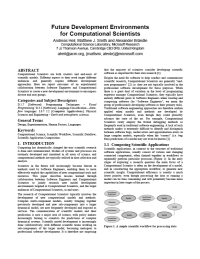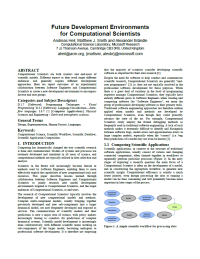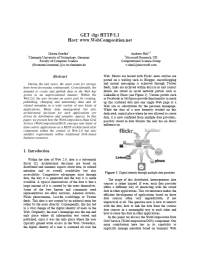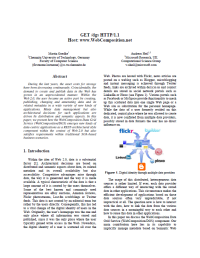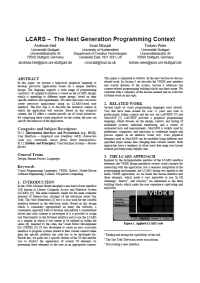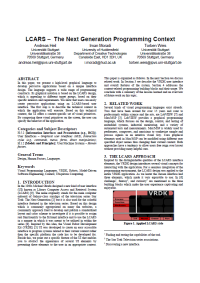Future Development Environments for Computational Scientists
Heil, A., Smith, M.J., Brändle, A..
Advanced Visual Interfaces 2010 (AVI’10)
May 25-29 2010
Rome, Italy
Proceedings of the International Conference on Advanced Visual Interfaces
ISBN 978-1-4503-0076-6
Pages: 406-406
Language: English
Computational Scientists are both creators and end-users of scientific models. Different aspects to their work target different audiences and generally require different development approaches. Here we report outcomes of an experimental collaboration between Software Engineers and Computational Scientists to create a new development environment to encompass diverse end user groups.
Download author version
Access via ACM Digital Library
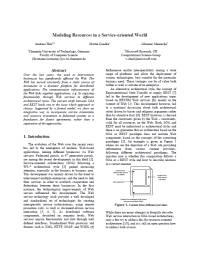 Lightweight Data Integration using the WebComposition Data Grid Service
Lightweight Data Integration using the WebComposition Data Grid Service
Sommermeier, R., Heil, A., Gaedke, M.
First International Workshop on Lightweight Integration on the Web (Composable Web’09)
Juni 22-26 2009
San Sebastian, Spain
Proceedings of the First International Workshop on Lightweight Integration on the Web
ISSN 1613-0073
Pages: 30-38
Language: English
Over the last years, the need to interconnect businesses has significantly affected the Web. The Web has moved constantly from a static source of documents to a dynamic platform for distributed applications. The communication infrastructure of the Web links together applications, e.g. by exposing functionality through Web services in different architectural styles. The current strife between SOA and REST leads one to the issue which approach to choose. Supported by a formal model, we show an integrative way to incorporate service orientation and resource orientation in federated systems as a foundation for future agreements rather than a separation of the approaches.
Download author version
Access via CEUR Workshop Proceedings
 Modeling Resources in a Service-oriented World
Modeling Resources in a Service-oriented World
Heil, A., Gaedke, M., Meinecke, J.
42nd Hawaii International Conference on System Sciences (HICSS-42)
January 5-8 2009
Waikoloa, Big Island, Hawaii
Proceedings of the 42nd Annual Hawaii International Conference on System Sciences
ISBN 978-0-7695-3450-3
Pages: 1-10
Language: English
Over the last years, the need to interconnect businesses has significantly affected the Web. The Web has moved constantly from a static source of documents to a dynamic platform for distributed applications. The communication infrastructure of the Web links together applications, e.g. by exposing functionality through Web services in different architectural styles. The current strife between SOA and REST leads one to the issue which approach to choose. Supported by a formal model, we show an integrative way to incorporate service orientation and resource orientation in federated systems as a foundation for future agreements rather than a separation of the approaches.
Download author version
Access via IEEE Computer Society Digital Library
GET /dgs HTTP/1.1 – Host: www.WebComposition.net
Gaedke, M., Heil, A.
42nd Hawaii International Conference on System Sciences (HICSS-42)
January 5-8 2009
Waikoloa, Big Island, Hawaii
Proceedings of the 42nd Annual Hawaii International Conference on System Sciences
ISBN 978-0-7695-3450-3
Pages: 1-10
Language: English
During the last years, the asset costs for storage have been decreasing continuously. Coincidentally, the demand to create and publish data in the Web has grown in an unprecedented manner. Within the Web 2.0, the user became an active part by creating, publishing, changing and annotating data and its related metadata in a wide variety of new kinds of applications. Many data management but also architectural decisions for such applications are driven by distribution and semantic aspects. In this paper, we present how the WebComposition Data Grid Service (WebComposition/DGS) emerges new kinds of data-centric applications as a REST-architectural style component within the context of Web 2.0 but also satisfies requirements within traditional SOA-based business scenarios.
Download author version
Access via IEEE Computer Society Digital Library
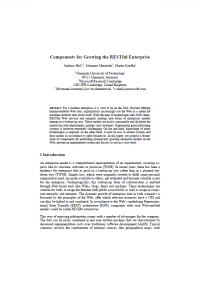 Components for Growing the RESTful Enterprise
Components for Growing the RESTful Enterprise
Heil, A., Meinecke, J., Gaedke, M.
Modellierung betrieblicher Informationssysteme (MobIS 2008)
November 27-28, 2008
Saarbrücken, Germany
Lecture Notes in Informatics (LNI)
P-141
ISBN 978-3-88579-235-2
Pages: 273-284
Language: English
For a modern enterprise, it is vital to be on the Web. Beyond offering human-readable Web sites, organizations increasingly use the Web as a media for machine-readable data about itself. With the help of technologies like XML feeds, RESTful Web services and semantic markup, new forms of enterprises models emerge in a bottom-up way. These models are easily consumable and facilitate the interaction with departments, partners and customers. Engineering good publishing systems is however extremely challenging. On the one hand, knowledge of many technologies is required; on the other hand, it must be easy to extend systems and data models in accordance to agile businesses. In this paper, we propose a framework of components for publishing dynamically growing enterprise models on the Web, present an implemented system and discuss its use in a case study.
Download author version
Access via Gesellschaft für Informatik
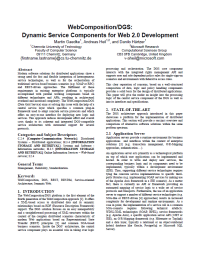 WebComposition/DGS: Dynamic Service Components for Web 2.0 Development
WebComposition/DGS: Dynamic Service Components for Web 2.0 Development
Heil, A., Gaedke, M., Härtzer, D.
International Conference on Advances in Mobile Computing & Multimedia (MoMM2008)
November 24-26, 2008
Linz, Austria
Proceedings of the 6th International Conference on Advances in Mobile Computing and Multimedia
ISBN 978-1-60558-269-6
Pages: 456-459
Language: English
Modern software solutions for distributed applications show a strong need for fast and flexible integration of heterogeneous service technologies, as well as for the orchestration of traditional service-based business scenarios (e.g. SOAP or RPC) and REST-driven approaches. The fulfilment of these requirements in existing enterprise platforms is typically accomplished with parallel working components based on different technologies and APIs, resulting in architectural overhead and increased complexity. The WebComposition/DGS (Data Grid Service) aims at solving this issue with the help of a central service layer which specifies a common plug-in framework used to adapt concrete service protocols and which offers an easy-to-use interface for deploying new logic and services. This approach reduces development effort and overall costs thanks to its coherent and integrated DGS-compatible service architecture with automated support for several protocols.
Download author version
Access via ACM Digital Library
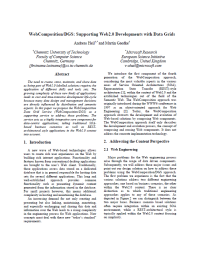 WebComposition/DGS: Supporting Web2.0 Developments with Data Grids
WebComposition/DGS: Supporting Web2.0 Developments with Data Grids
Heil, A., Gaedke, M.
IEEE Congress on Services (SERVICES 2008)
September 23-26, 2008
Beijing, China
Congress on Services Part II, 2008
ISBN 978-0-7695-3313-1
Pages: 212-215
Language: English
The need to create, store, maintain, and share data as being part of Web 2.0 labelled solutions requires the application of different skills and tools sets. The growing complexity of these new kinds of applications leads to cost and time-intensive development life-cycle because many data design and management decisions are directly influenced by distribution and semantic aspects. In this paper we propose the Web composition data grid service (Web Composition/DGS) as a supporting service to address these problems. The service acts as a highly integrative core component for data-centric applications, taking traditional SOA-based business scenarios as well as REST-architectural style applications in the Web 2.0 context into account.
Download author version
Access via IEEE Xplore Digital Library
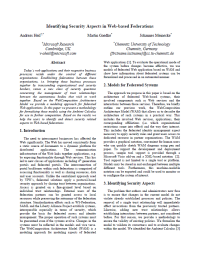 Identifying Security Aspects in Web-based Federations
Identifying Security Aspects in Web-based Federations
Heil, A., Gaedke, M.
IEEE International Conerence on Web Services (ICWS 2008)
September 23-26, 2008
Beijing, China
Proceedings of the 2008 IEEE International Conference on Web Services
ISBN 978-0-7695-3310-0
Pages: 807-808
Language: English
Today’s web applications and their respective business processes reside under the control of different organizations. Establishing federations between these organizations, i.e. bringing these business processes together by transcending organizational and security borders, raises a new class of security questions concerning the management of trust relationships between the autonomous bodies that wish to work together. Based on the WebComposition Architecture Model we provide a modeling approach for federated Web applications. In this paper we present a methodology for formalizing these models using the Ambient Calculus for use in further computation. Based on the results we help the users to identify and detect security related aspects in Web-based federations.
Download author version
Access via IEEE Xplore Digital Library
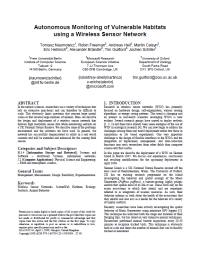 Autonomous Monitoring of Vulnerable Habitats using a Wireless Sensor Network
Autonomous Monitoring of Vulnerable Habitats using a Wireless Sensor Network
Naumowicz, T., Freeman, R., Heil, A., Calsyn, M., Hellmich, E., Brändle, A., Guilford, T., Schiller, J.
REALWSN’08 Workshop on Real-World Wireless Sensor Networks
April 1, 2008
Glasgow, Schottland
ISBN 978-1-60558-123-1
Pages: 51-55
Language: English
In the natural sciences, researchers use a variety of techniques that rely on extensive man-hours and can therefore be difficult to scale. This obviously limits questions that concern large spatial scales or that involve large numbers of animals. Here, we describe the design and deployment of a wireless sensor network that delivers high resolution sensor data while monitoring seabirds on a UK National Nature Reserve. We describe some of the problems encountered and the solutions we have used. In general, the network has successfully demonstrated its utility in a real world scenario and will be extended and enhanced for the coming field season.
Download author version
Access via ACM Digital Library
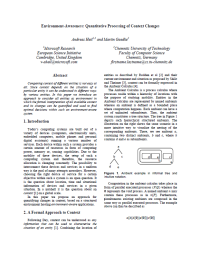 Environment-Awareness: Quantitative Processing of Context Changes
Environment-Awareness: Quantitative Processing of Context Changes
Heil, A., Gaedke, M.
Sixth Anual IEEE International Conference on Pervasive Computing and Communications (PerCom 2008)
March 17-21, 2008
Hong Kong
ISBN 978-0-7695-3113-7
Pages: 432-428
Language: English
Comparing context of different entities is not easy at all. Since context depends on the situation of a particular entity it can be understood in different ways by various entities. In this paper we introduce an approach to consider all entities as environment in which the formal interpretation of all available context and its changes can be quantified and used to find optimal decisions within such an environment-aware system.
Download author version
Access via IEEE Xplore Digital Library
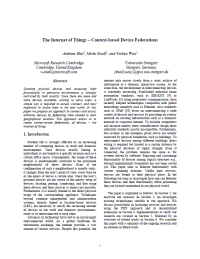 The Internet of Things – Context-based Device Federations
The Internet of Things – Context-based Device Federations
Heil, A., Knoll, M., Weis, T.
Hawaii International Conference on System Science
January 3-6, 2007
Waikoloa, Big Island, Hawaii, USA
Proceedings of the 40th Annual Hawaii International Conference on System Sciences (HICSS’07)
ISBN 0-7695-2755-8
Pages: 58a
Language: English
Locating physical devices and accessing their functionality in pervasive environments is strongly restricted by their locality. Since there are more and more devices available, waiting to serve users, a simple way is required to access, connect, and most important to locate them in the real world. In this paper we propose an approach to connect and access arbitrary devices by federating them related to their geographical location. This approach allows us to create context-aware federations of devices – the internet of things.
Download author version
Access via IEEE Computer Society Digital Library
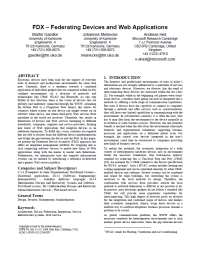 FDX – Federating Devices and Web Applications
FDX – Federating Devices and Web Applications
Gaedke, M., Meinecke, J., Heil, A.
International Conference on Web Engineering (ICWE’06)
July 11-14 2006
Palo Alto, CA, USA
Proceedings of the 6th International Conference on Web Engineering
ISBN 1-59593-352-2
Pages: 95-102
Language: English
Electronic devices have been used for the support of everyday tasks in domestic and professional environments for some time now. Currently, there is a tendency towards a combined application of individual gadgets that are connected within locally confined environments via a diversity of protocols and technologies like UPnP, WLAN and Bluetooth. As one step further in this direction, there is the vision of devices that are globally and uniformly connected through the WWW, extending the Mobile Web to a Ubiquitous Web. Hence, this allows for scenarios where actions on one device can trigger events on an arbitrary other device, and where third-party Web services from anywhere in the world are involved. Ultimately, this results in federations of devices and Web services belonging to different households, companies, suppliers and service providers, forming new kinds of Web applications that integrate devices as an additional dimension. To fulfill this vision, solutions are required that are able to abstract from the different device implementations and bridge the gap between the device and the Web. In this paper, we present the Federated Device Assembly (FDX) approach that offers an integrated management platform for wrapping and as such connecting arbitrary devices to enable new forms of Web applications along with the means to model such federations. Furthermore, we demonstrate how the required infrastructure systems can be realized by introducing a reference architecture and a generic Web service interface.
Download author version
Access via ACM Digital Library
LCARS – The Next Generation Programming Context
Heil, A., Moradi, I., Weis, T.
Advanced Visual Interfaces (AVI 2006)
May 23-26 2006
CAI ’06 Proceedings of the International Workshop in conjunction with AVI 2006 on Context in Advanced Interfaces
Pages: 29-31
Language: English
In this paper, we present a high-level graphical language to develop pervasive applications based on a unique interface design. The language supports a wide range of programming constructs. Its graphical notation is based on the LCARS design, which is appealing to different target groups, based on their specific interests and requirements. We show that users can easily create pervasive applications using an LCARS-based user interface. The first step is to describe the technical context in which the application will execute. Based on this technical context, the UI offers a context-specific set of visual primitives. By composing these visual primitives on the screen, the user can specify the behavior of the application.
Download author version
Access via ACM Digital Library
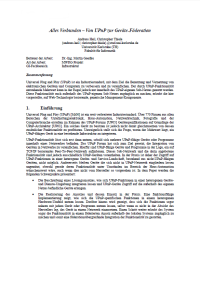 Alles Verbunden – Von UPnP zur Geräte-Föderation
Alles Verbunden – Von UPnP zur Geräte-Föderation
Heil, A., Thiele, C.
Informatiktage 2006
March 31 – April 1 2006
Bonn, Germany
Lecture Notes in Informatics (LNI) – Seminars
Volume S-3
ISBN 3-88579-437-3
Pages: 95-100
Language: German
Universal Plug and Play (UPnP) is a de-facto standard to improve and simplify both, the usage and the linking of electrical devices and computers. However, the added value is only available within a certain UPnP sub-network. The generic web technology based management component, described in this paper, allows providing the functionality outside of such a particular UPnP sub-network.
Download author version
Access via Gesellschaft für Informatik
